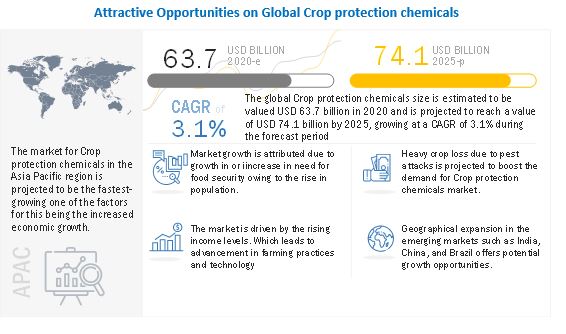The global crop protection chemicals market size is estimated to be valued USD 63.7 billion in 2020 and is projected to reach a value of USD 74.1 billion by 2025, growing at a CAGR of 3.1% during the forecast period. The growth of this market is attributed to the increasing need for food security of the growing population.

COVID-19 Impact on the Crop protection chemicals:
COVID-19 impact on the crop protection chemicals is low to moderately affected. There has been disruptions in the suppy chain and distribution channels to transport pesticides across different countries and continents. However, the production has been slightly affected, and the production is reduced for upto 20% across Asia Pacific and Europe.
Download PDF Brochure: https://www.marketsandmarkets.com/pdfdownloadNew.asp?id=380
Driver: Increase in need for food security owing to the rise in population
According to the International Food Policy Research Institute, almost 690 million people went hungry around the world in 2019, an increase of 10 million over 2018, and the COVID-19 pandemic could push an additional 83 milllion-132 million into chronic hunger in 2020, according to the 2020 State of Food Security and Nutrition in the World (SOFI) report, released July 13. The report provides the latest authoritative estimates on global hunger, malnutrition, and food insecurity.
State of Food Security and Nutrition in the World (SOFI) 2020 projects that 841.4 million people will be hungry globally by 2030 if these trends continue, and the world will not achieve its 2025 and 2030 targets of defeating malnutrition. According to the FAO Chief Economist, attributed these alarming findings to the unaffordability of healthy diets, noting that globally, 3 billion people lack the means and access to good nutrition. In order to transform food systems to reduce these costs, policy makers must look at both supply and demand. Policies should enhance the efficiencies of the food supply chain and subsidize production of nutritious foods; at the same time, expanding social safety nets and policies that encourage behavioral change can promote healthier diets.
People are considered to have food security when they have access to safe, nutritious, and sufficient food at all times to maintain a healthy life. Due to the continuous rise in population and limited cultivable land to suffice the growing need for food, there is less food security for the people. To fulfill the future demand for food, there is a need to increase food production across the world. In such a scenario, the use of crop protection products is inevitable. This situation has driven the growth of the crop protection chemicals market.
Restraint : Pesticide residue problems
Pesticides due to their persistent nature, toxic properties, bioaccumulation, lipophilicity, and adverse impacts on human health are of greater concern due to such residue problems. These pesticides enter the human body through consumption of contaminated fruits and vegetables. The major health impacts associated with pesticides residue include cancers, birth defects, neurological disorders, endocrine disruptors, and reproductive effects. The effect of a pesticide is determined by the duration of exposure and toxicity of a pesticide. The effects which can be caused are either acute or chronic.
Make an Inquiry: https://www.marketsandmarkets.com/Enquiry_Before_BuyingNew.asp?id=380
South America is estimated to hold the largest market share during the forecast period
South America is an emerging agricultural powerhouse, growing at a rapid pace above the global growth average. Growth in this region is significantly contributed by the growth in Brazil and Argentina, which are the world’s most potent agricultural producers and are expected to grow well above the regional average. The economic growth in South America has been stimulated by democratization, economic reforms, and the foundation of the two trading blocs namely, Mercosur and the Andean Pact.
This report includes a study on the marketing and development strategies, along with a study on the product portfolios of the leading companies operating in the Crop protection chemicals. It consists of the profiles of leading companies such BASF SE (Germany), The Dow Chemicals Company (US), Dupont (US), Sumitomo Chemical Co., Ltd (Japan), Syngenta AG (Switzerland), Bayer Cropscience AG (Germany), FMC Coropration (US), NufarmLimited (Australia), Adama Agricultural Solutions (Israel), Verdesian LIfescineces (US), Bioworks Inc. (US), Valent US (US), Arysta Lifescince Corporation (US), American Vanguard Corporation (US), Chr. Hansen (Denmark), Corteva Agrisciences (US), UPL Limited (India), Jiangsu Yangnong Chemical Group Co Ltd (China), Agrolac (Spain), Lianyungang Liben Crop Science Co. Ltd. (HongKong), Nanjing red sun co. ltd (China), Kumiai Chemicals (Japan), Wynca Chemicals (China), Lier Chemicals (China), Simpcam Oxon (Italy).